Here’s Why you need an Awesome Company Website Design
There’s a lot at stake regarding your company website these days. It’s the digital representation of you as a business – often how potential customers first see you. And, you know what they say about first impressions…they count for quite something.
Consider how you evaluate a firm based on its website. Positive feelings towards that brand begin developing automatically if it is slick, modern, and user-friendly. But if their site is an archaic shambles? Well, let’s just say that this does not precisely breed confidence.
Great company website design is not just something nice to have now – it is necessary for businesses across every industry and size bracket. Do it right, and things will go well; do it wrong though and… well, don’t wonder why attracting and retaining customers may be challenging.
Still unconvinced? Then keep reading, and we’ll discuss why company website design demands your utmost attention and investment!
Table of Contents
Building Trust and Credibility

You have likely heard the saying “You never get a second chance to make a first impression” several times before. It is true – particularly as far as your business website is concerned.
Just think about it: should someone run into your website and find it shoddy or plain ugly, what will they deduce of the entire business? They will likely infer that you are not a professional, respectable group.
On the other hand, an exceptionally designed site tells your potential clients that you are trustworthy, attentive to details and proud of your online presence. This degree of professionalism and shine can go incredibly far in today’s world, where people are bombarded with various businesses vying for attention.
It all comes down to fundamental human psychology. We tend to naturally believe in entities that “look the part” rather than those that appear untidy or haphazard. By getting your website design right, you establish trust and credibility with your readers even before they read any content on your pages.
Standing Out from the Crowd
To be frank, whatever sector you belong to, you are up against huge competition. Potential customers have a limitless number of choices at their fingertips.
But how can you make yourself different and get attention? Undoubtedly, through a fantastic website design.
Unlike your competitors, who may simply assemble plain Jane sites without thinking about it, a superior site will help you cut out from the noise instantly. From the outset, your target group knows you always go further to create a great user experience.
Moreover, just think about how captivating and memorable visually impressive websites appear compared to dull template ones. Therefore, if your design has that unique “wow” factor, then as people navigate online, it is more likely that they will stick to your mind.
Lastly, great design lets one escape the clutter and establish what makes their brand unique. It signals ingenuity, innovation, and good taste right from the start. Given this fact, you can understand why difference counts a lot.
Do Looks Matter That Much? Yes, They Do!
You may be thinking, “Yeah, but does website design hold that much importance? Shouldn't substance matter more than style?” And you would have had a point…if anything other than websites were being discussed.
Here is the thing: In our digitalised world, your company’s website is the substance. It is a product, service, and brick-and-mortar experience for many contemporary businesses and clients. So what about its design? Well, it can be viewed as packaging or wrapping. Just like other products, the packaging plays a significant psychological role.
For example, consider shopping for products in a store on shelves; although if appearance doesn’t count, you can buy something just because it works well. However, most of the time, you will probably choose an item with great packaging rather than its simply packaged rival. People are naturally attracted to things that they find visually appealing.
The same principle holds when applied to full swing on the web. If you have two competing businesses that offer similar products or services, then one with better “packaging”—which means having a more professionally designed website—has the upper hand because it will grab people’s attention and interest.
Therefore, no looks aren’t everything. However, they carry much more weight than some people might imagine, mainly when dealing with matters concerning digital space. Do not underestimate excellent design!
User Experience is Everything

Beyond aesthetics, a good company website design goes beyond being visually appealing. This means that, on the inside, it is all about making your site more user-friendly.
What is referred to as User Experience (UX)? It may incorporate how rapidly pages are uploaded to how easily visitors can access important information or perform their desired actions, such as checkout.
And let me tell you – investing time and resources into perfecting UX pays off in spades. The more accessible and cheerful you make things for users to navigate your webpage, the longer they will remain. The longer they stick around, the higher your chances of converting them into paying clients.
On the other hand, bad user experience ultimately converts potential buyers away. Should your site be cumbersome, confusing when navigating through it, load sluggishly or simply irritate them at large, then know that they will leave you soonest, if not immediately, but might opt to visit another site similar to yours.
Excellent UX makes people stay. High bounce rates are avoided. Casual browsers become interested prospects and satisfied customers. Isn’t that amazing?
Nevertheless, please don’t ever place more emphasis on visuals than user interface designs, even though visual appeal counts a lot, too. They should go together so well that both nail them with internet marketing strategies and get ready for incredible achievements online!
Mobile-First Design is Non-Negotiable
The delivery of fantastic user experiences is similar to that of mobile devices today. This is a world where more people access the internet using smartphones and tablets than those who use desktop computers.
However, many businesses still need websites that are designed for mobile users. Trust me; browsing an unresponsive website on your phone or tablet can be annoying.
You may abandon websites if you realise they must be optimised for your mobile device. The same goes for today’s customers, who are always on the move. Unless your site looks superb and functions impeccably regardless of someone’s device, forget about those mobile visitors altogether.
That is why any company website from 2024 onwards must incorporate a mobile-first design approach. Your whole user experience must prioritise the seamless journey of users on cell phones above all else.
So whether it involves restructuring navigation for small touch screens, doing away with annoying mouse hovers in favour of tap responsiveness, resizing contents for limited displays, adopting thumb-friendly design principles or ensuring faster load times to cater for people on the go, do everything possible just to make sure you entertain visitors using their phones.
This segment grows annually without exception and punishes brands failing to go along. Do not belong among ill-advised brands; embrace the concept of ‘mobile first’ when designing your corporate site.
Boosting Conversions and Sales

Hopefully, by this point, you're buying into the importance of fantastic website design and how it impacts brand perception, differentiation, user experience, and beyond. But if you still need more convincing, let's discuss what matters most: cold, complex conversions and sales.
Businesses invest in digital properties like websites to drive customers to take action. Whether you want people to purchase your products/services, schedule appointments, sign up for your email list, or whatever else… excellent design plays a pivotal role in facilitating those conversions.
Consider the stark differences between converting customers to a beautifully designed website and a disorganised mess. On the lovely one, calls-to-action jump off the page and offer crystal-clear next steps. Information is organised intuitively. Everything loads instantly.
But on the lousy site? CTAs need to catch up in visual clutter. Navigation is a nightmare. Pages freeze up constantly. It's a frustrating, headache-inducing experience that'll have most folks bouncing quicker than you can blink.
The data more than backs up how robust thoughtful design can be for boosting those ever-important conversions. Studies show that well-designed websites can see conversion rate increases of 200% or higher compared to their poorly designed counterparts. And at the enterprise level, even minor design enhancements have led to hundreds of millions in additional revenue for significant brands.
The numbers don't lie – exceptional website design directly correlates to more leads, sales, signups, and whatever conversion goals you're chasing. I don't know what it is if that's not incentive enough to prioritise this stuff!
So, consider aesthetic appeal and general credibility when planning your company site redesign. But laser in on converting visitors into customers, clients, or subscribers. Everything from your layouts to your CTAs to checkout flows needs to be surgically optimised for driving action.
Treat design as an invaluable business investment, not just a surface-level brand polisher. Get this right, and the ROI will follow.
Why A/B Testing is Crucial
Even with a great general website design, there is always room for growth to improve conversions. What is the best way to know those areas that need to be optimised? A/B Testing.
The concept is simple: you create two slightly different versions of a page or funnel, divide the traffic between them and then determine which one converts better. It lets you take a data-driven approach to refining your designs more specifically based on what users do.
Perhaps changing the colour of a “Buy Now” button will increase purchases by 15%. Or rewriting the product description into a lively, more engaging style improves add-to-cart actions by 10%. These are minor changes; however, they could result in significant conversion rate improvements over time, particularly when testing continues without ceasing.
And guess what? Rather than hunches, actual user data influences ongoing design and UX improvements. Calculated adjustments can be made rather than guessing in the dark without any guesswork.
A/B testing helps get the most out of your web design investment. This prevents you from resting on your laurels and allows you to improve the experience significantly. Highly profitable firms continuously use A/B tests for their conversion rate optimisation (CRO) efforts.
To increase conversions, sales, and ROI (which should be everyone’s goal), allocate funds for ongoing A/B testing. After that, iterate, analyse, and repeat this process for even more untamed growth!
The Need for Speed
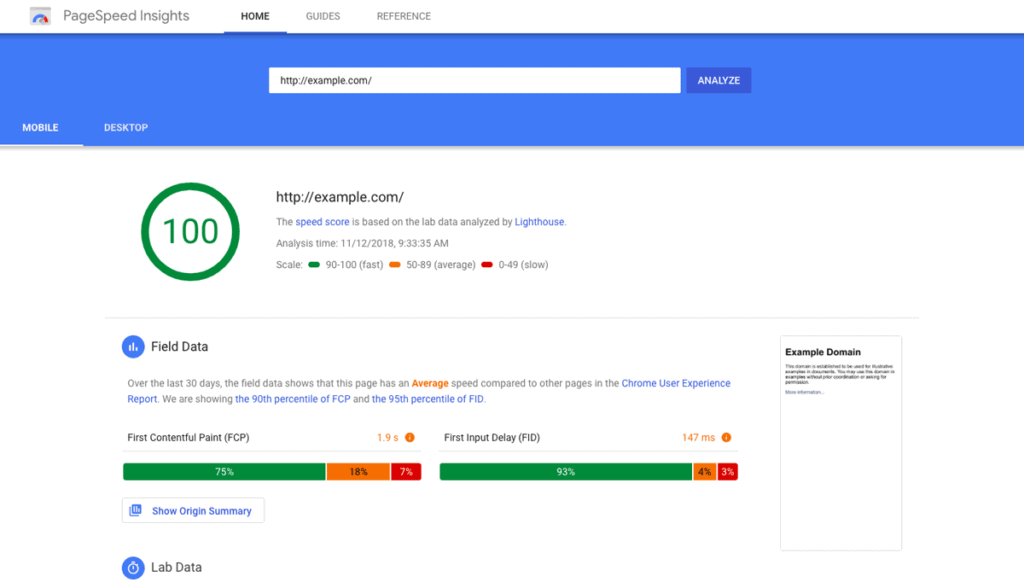
We've covered a lot of ground on why company website design is vital from branding, UX, and conversion perspectives. However, site speed is one factor that trumps them all regarding sheer importance.
Simply put, a slow-loading website is the digital equivalent of a kick to the shins. It doesn't matter how brilliant the visuals are or how easy the navigation seems if people have to wait an eternity for anything to load.
And we're talking even slight delays here, not just full-blown frozen screens. Research shows that a 1-second delay in site speed can hurt conversion rates by a staggering 7%. And those drop off a cliff from there the longer they wait. A 5-second load is enough to bounce nearly a third of visitors away!
The truth is that in 2024's fast-paced world, people have nanosecond attention spans. If your site keeps them waiting, they'll simply give up and quickly take their business elsewhere.
From a technical design standpoint, this means optimising the living daylights out of all your site code, image files, libraries, you name it. Stripping bloat, delaying offscreen resource loading, hosting assets on CDNs, minimising HTTP requests, tuning servers to perform at peak efficiency… not an inch of code can go unoptimised.
This would be a no-brainer for businesses at this point, yet site speed remains a constant struggle for so many. Stay caught up on it! Lightning-fast load times are non-negotiable, so spend whatever resources are needed to be a total rapid-delivery champ compared to your dawdling competitors.
Optimise for “Impatient Perfectionism”
As if the site speed stats we cited earlier weren't staggering enough, here's another mind-blowing one: nearly 70% of customers admit to being “impatient perfectionists” who expect a perfect, seamless digital experience every single time.
Oof, talk about demanding! But that's just the level modern web users have been conditioned to – and businesses better deliver if they don't want to get left behind.
So, what does optimising for impatient perfectionists even mean from a technical website design perspective? Well, as crucial as that is, it involves more than raw site speed.
Every single micro-interaction on your site must be buttery, smooth and painless. Even slight delays or sources of friction – maybe an effect that lags for half a second or a hover state that feels slightly clunky – are the kinds of “imperfections” that'll drive these demanding users crazy.
Forms must be easy to complete with innovative auto-fill capabilities and zero lag between typing and text rendering. Videos better stream flawlessly without a hint of buffering or stutter. Shopping carts should update quantities at lightning speed with delightful micro-animations.
You get the idea – anything short of a 100% seamless, responsive and “perfect” journey at every step will turn off cranky, impatient perfectionist types. Far too many brands are losing big money and customers because their sites are full of tiny hangups that disrupt the flow and annoy people.
So, obsess over every last pixel and micro-interaction during the design process—triple-check performance across various devices and connection speeds. And be relentless about sanding out any lingering frictions or imperfect moments.
It's a ton of work, sure. But delight those impatient perfectionists, and they'll reward you with tons of loyalty and business for meeting their lofty user experience expectations.
SEO & Search Marketing Tie-Ins

Until now, we've primarily focused on why fantastic website design is critical from a user experience and conversion perspective. But remember that it plays a huge role in search engine optimisation (SEO) and overall search marketing performance.
These days, Google and other major search engines view metrics like load speed, mobile-friendliness, navigation structure, multimedia integration, and overall quality when crawling and ranking sites. Design hugely impacts nearly all those signals in one way or another.
Translation? If your website's design needs to be improved on any of these fronts, it may get penalised with lower rankings in search results. And you'd better believe people need help finding or clicking through to your site if it's buried on page 7 of Google.
Conversely, a superbly designed website that nails core web vitals while presenting an A+ user experience stands a much better chance of surging up those all-important SERPs. SEO visibility is like a rising tide that lifts all conversion metric boats.
Furthermore, your website's look and interactivity are essential when converting searchers into customers once you've snagged those top rankings. Because let's face it – people are quick to hit the “back” button if your enticing listing leads to an underwhelming site.
Understanding and executing on-page SEO best practices (from optimised copy to keyword targeting to alt text and more) is crucial. But it must be paired with a brilliant search-engine-optimised website design for the full one-two SEO punch.
So, as you're thinking through design plans, focus on more than just the human audience. Think from search engines' perspectives, too. Map out ways to visually reinforce relevance through multimedia. Ensure navigation concepts support crawlability. Balance aesthetics with technical optimisations.
Knock this out of the park, and you'll be swimming in more traffic and visibility than you know what to do with!
Why Amazing Design Keeps ‘Em Coming Back
We've touched on how fantastic website design reels visitors in, builds brand affinity, provides exceptional UX, and maximises conversions. However, savvy business owners know that customer lifetime value surpasses just that first sale.
The long-term profits come from retaining those hard-won customers over months and years through continued loyalty. And yes, thoughtful site design also plays a massive part in supporting that higher lifetime value.
Think about it: once you've snagged a customer's business, that beautifully designed website continues serving as their primary interaction point with your brand. If it remains a joy to use, they'll keep coming back time and again for a premium experience.
But let your website experience degrade or grow stale, and those same folks will slowly start doubting their decision to buy from you in the first place. Eventually, they'll gravitate toward whichever competitor provides a better digital journey.
This is why site design should be treated as something other than a one-and-done affair. Yes, you want to come out guns blazing with a brilliant new website to capture attention and convert visitors immediately.
But you have to think about adaptability and continuous iteration, too. Customer demands, device trends, and design fashions – are constantly evolving in our fast-paced world. Your site must evolve alongside them to retain its lustre and prevent stagnation.
The best brands are constantly working on refreshing their designs every few years while pushing out regular updates and enhancements. A full-blown redesign is optional annually, but consistent adjustment should be the norm.
As those technologies progress, they're doubling down on “trendy” immersive website elements like 3D, augmented reality, animation, and micro-interactions. Not just doing it for the sake of being flashy but also purposefully using them to elevate digital brand experiences further.
The end goal? Cementing your awesomely designed company website as a familiar, engaging, unshakable part of customers' online routines and lives. Something they actively look forward to interacting with rather than begrudgingly tolerating.
Get that right through consistent, forward-thinking, user-centric design optimisations. You can practically guarantee those lifetime value numbers will keep climbing for years.
Getting Buy-In for Great Website Design
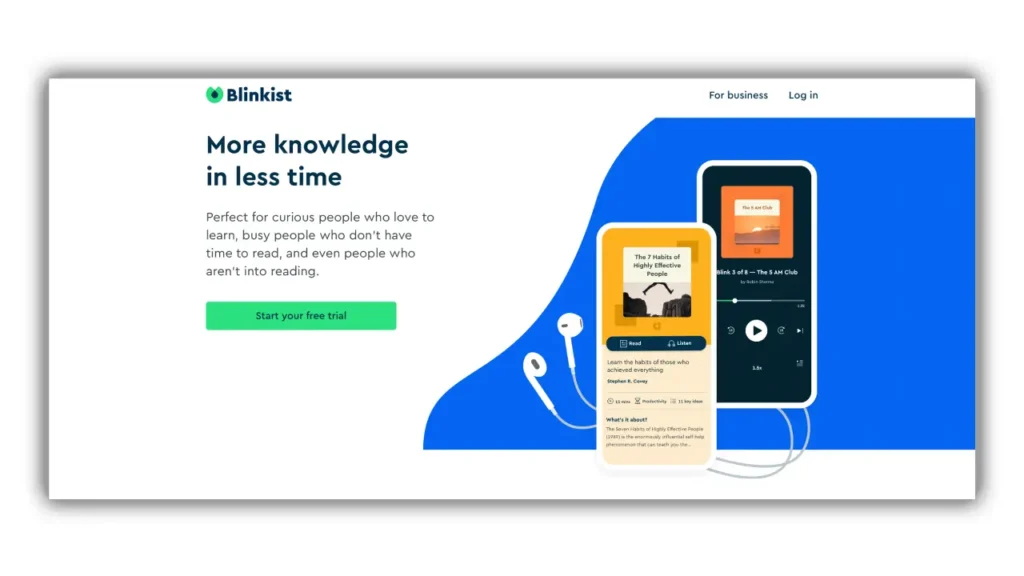
At this point, you're convinced that exceptional website design is worth investment for virtually any modern-day business. From fortifying brands to boosting conversions to driving SEO visibility and so much more, the potential returns are just too significant to overlook.
However, your leadership team or higher-ups may need more convincing before green-lighting major design overhauls. So here's how to make that all-important business case and get buy-in from key decision-makers:
Show The Money
Above all else, speak to them in the language every business stakeholder understands: cold, complex numbers and ROI projections.
Yes, you can cite qualitative benefits like better UX or brand perception. But concentrate most heavily on compiling data around how significant website redesigns translate into measurable revenue lifts; customer acquisition increases, lower bounce/cart abandonment rates, higher conversions… all the metrics that equate to company-wide impact.
Use real-world case studies from respected sources rather than self-reported claims. Point to ways a new site design could enable hitting X% higher conversion rates like one of your competitors did. Or how a specific tweak led to X million dollars in added income for Company X.
Map everything to precise financial modelling backed by industry benchmarks. Do it right, and you can justify what may seem like a heavy upfront investment by projecting returns that far outweigh the short – and long-term costs.
Push The Branding Perspective
Chances are, many decision-makers at your company – especially non-marketing folks – don't fully grasp the level of brand equity at stake with digital properties like websites. So hammer that home.
Simply put, your company website is the new digital front door welcoming customers into your brand's world. Let it be perceived as lacklustre, dated, or frustrating to use, and you're immediately diluting brand reputation right out of the gate.
But invest in constructing an authentic, best-in-class web experience? That's a surefire way to stand out from competitors, build trust, and have potential customers walking away impressed before they've even read a single word about your offerings.
Anecdotes and accurate consumer data also drive this home in powerful ways. Cite firsthand social proof and surveys highlighting how exceptional website design leaves people feeling about particular brands. Or show examples where a dated site triggered brand perception plummets.
Either way, the message is clear: brand equity is priceless, and remarkable design is integral to building/preserving/growing that equity in the digital age. That alone justifies the spending.
Sell On Competitiveness And Future-Proofing
Your brand may need to catch up to competitors in the website design department. You may have legacy pages that are sorely in need of modernisation. Whatever the situation, highlight how strategic design upgrades will solidify your market position and leave rivals scrambling to catch up.
Look at concrete competitor data side-by-side with your site analytics. Point out ways their superior design translates to real-world advantages like lower bounce rates, more transactions, and better engagement metrics. Then, outline detailed plans for leapfrogging them through upgraded navigation, optimisation, responsive layouts, etc.
Remember to sell decision-makers on future-proofing benefits, too. Yes, a redesign tackles current weaknesses. But emphasise how prioritising great design sets the stage for rapidly adapting to emerging user behaviour trends, new technologies, evolving search engine algorithms, and more down the road.
Appeal to their desire to build a sustainable digital presence rather than repeatedly playing catch-up against more forward-thinking competitors every few years. Nothing motivates me like the prospect of getting permanently ahead of the curve.
Involve Them In The Process
Lastly, a little human psychology tip: involve critical stakeholders throughout the actual redesign process from an early stage. Don't just sell them on the outcome.
Have them participate in kickoff meetings where initial creative ideas get brainstormed. Loop them into prototyping feedback sessions to ensure designs resonate with their perspective. Share user testing videos capturing unfiltered reactions to the new experience.
They should be turned into invested partners who help drive the creative process and decision-making, not just passive recipients of an end product. People inherently place more value and appreciation in things they feel ownership toward.
So make them active participants! Not only does it increase chances of approval by making them part of the journey, but their hands-on experience will highlight just how meticulous and valuable professional website design truly is.
Real-World Examples of Killer Company Website Design
Enough talk about principles and theories – see real-world examples of organisations completely knocking it out of the park regarding website design! These inspiring cases run the gamut from scrappy startups to established enterprise giants in various industries.
Mailchimp
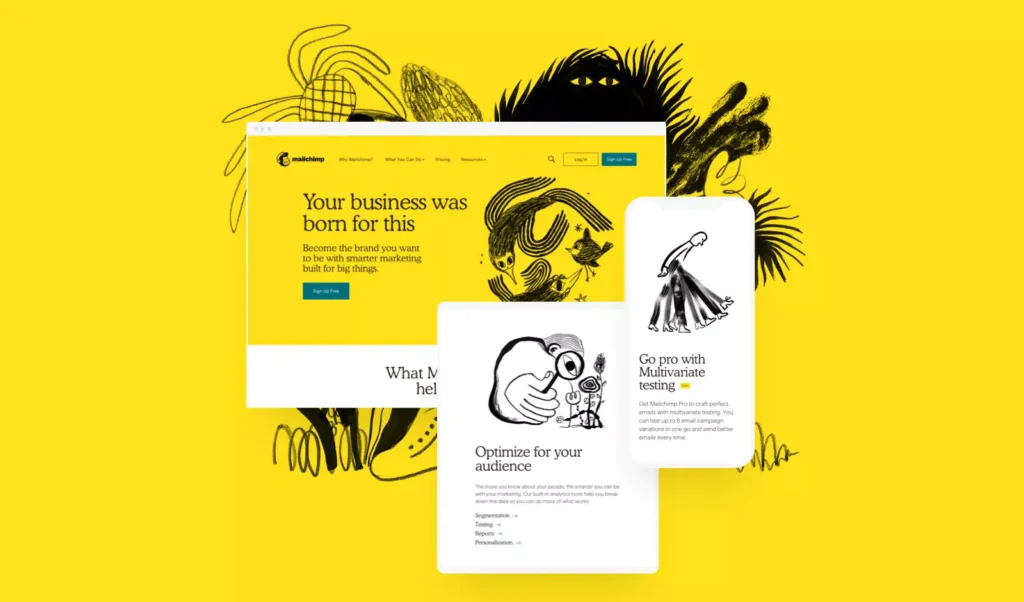
Mailchimp's email marketing platform has long been heralded for its whimsical, personality-packed website that perfectly captures the brand's signature humour and flair. Everything from the bold colours and fun illustrations to the playful microcopy delights visitors right out of the gate.
But it's not just style over substance – the actual UX and usability are also fantastic. The navigation is incredibly clean and intuitive, getting you to critical resources at lightning speed. Interactive walkthroughs guide new users through complex features. And delightful little touches like creative error screens turn typical digital headaches into smile-inducing moments.
Oh, and the loading speeds? It's blazing fast on both desktop and mobile. Mailchimp shows how much an optimised, meticulously designed website enhances a digital product like theirs.
The brand invested significant resources into nailing the tiniest details through its stellar site. Those resources have paid substantial dividends in customer acquisition and brand affinity, and they have turned what could've been yet another clunky SaaS platform into a category leader in digital delight.
Burt's Bees

Who would've thought a humble skincare beauty products company could cultivate a captivating website experience? But that's precisely what Burt's Bees has pulled off with their rich, vibrant, multimedia-driven site design.
From the breathtaking visuals of their sticky video “header” to the gorgeous product photography to the delightfully animated page transitions, visitors' senses are enthralled every step of the journey. The creators put much thought into seamless interactions and microcopy while highlighting the brand's all-natural ingredients and sustainable practices.
Yet, for all the slick aesthetic flair, Burt's Bees retained an ounce of UX clarity and conversion prowess. The ecommerce flows for browsing and buying products are buttery smooth on both desktop and mobile. Persistent in-line CTAs nudge you towards desired actions at the perfect cadence. And user-generated content like reviews gets beautifully woven in.
It's an actual master class in balancing stunning visual design with ruthless sales effectiveness. No detail was too small for the team to scrutinise across all touchpoints. Burt's Bees serves as excellent inspiration for how great art direction and ecommerce conversion ability can perfectly co-exist in one seamless digital package.
Backcountry
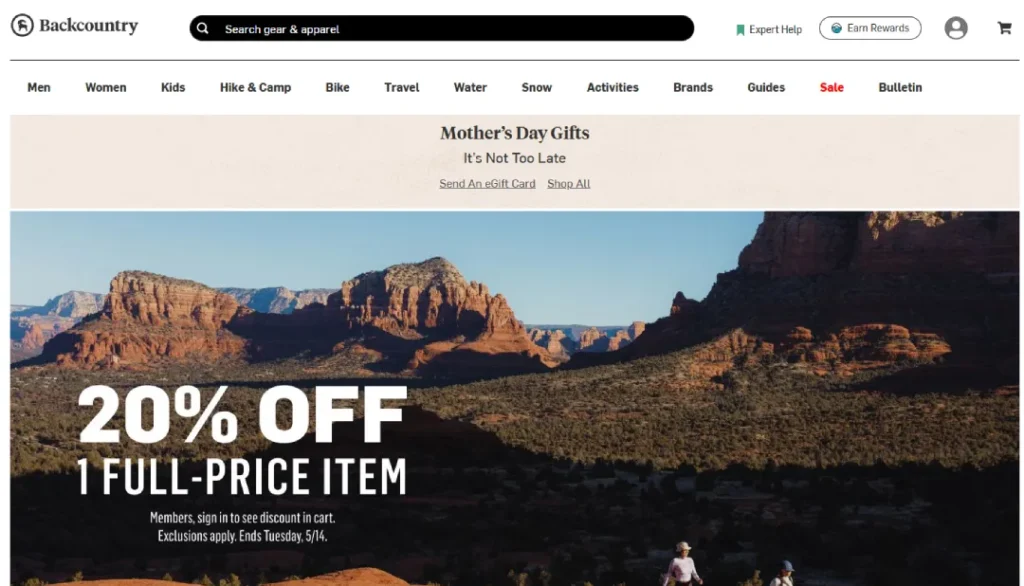
Creating exceptional website experiences for highly utilitarian sites focused on transactions can be challenging. However, the outdoor recreation retailer Backcountry shows how it's achievable with brilliant, purpose-driven visual design.
Their homepage alone hits you with breathtaking mountain scenery, cleverly minimal overlayed navigation, and punchy copy, all precisely aligned to reinforce their adventurous brand vibes. Those themes are consistently carried through on category pages with a beautiful balance of atmospheric videography, product imagery, and conversion-optimized layouts.
Backcountry shines on the product detail pages and checkout funnels. Rather than defaulting to bland, generic ecommerce templates, their designers injected tons of personality. Everything feels thoughtful and geared towards the adventurer mindset, from engaging product storytelling with striking photography to handy comparison tools to a delightful checkout experience with animated micro-interactions.
It's a masterclass in utilising powerful visuals and animations not just for pure art's sake but as tools to reinforce your brand narrative and provide utility to customers. Backcountry walks that tightrope of inspired design and flawless usability to perfection.
The website is ruggedly beautiful yet stripped of any distractions when it's time to facilitate easy purchasing. It demonstrates how going the extra mile on purposeful, meaningful web design can cultivate incredible customer experiences beyond basic transactions.
Curology
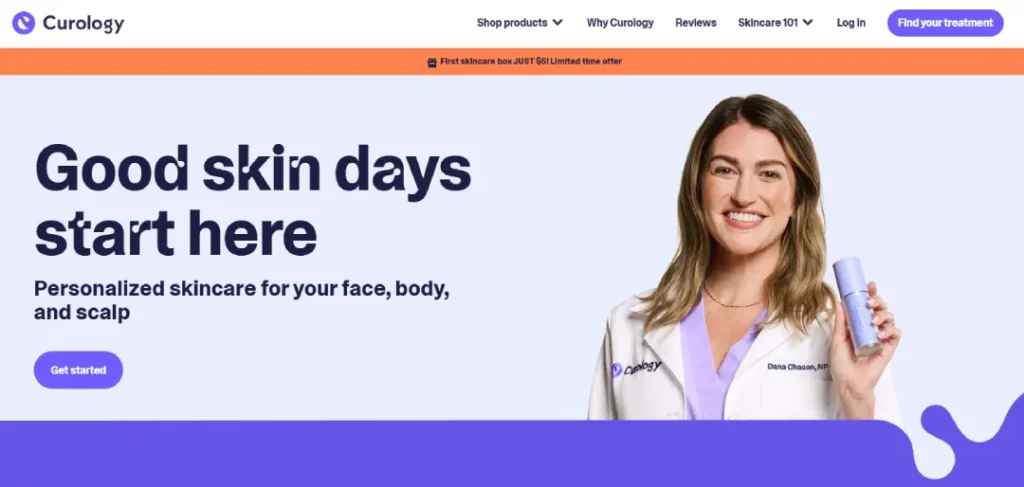
In the crowded, rather unsexy world of skincare brands, Curology built an online presence that emanates style and modernity from the second you land on their website.
The minimalist colour palette, striking product photography, and playful animations instantly grab your attention and establish a premium, sophisticated vibe. However, the delightful microcopy and unique illustrated elements allow Curology's quirky personality to pop throughout the experience.
From the consultative onboarding flow asking you to map your skincare goals to the interactive educational content explaining their products' science, everything reinforces their innovative approach with clever copywriting and unconventional visuals.
And despite throwing tons of thoughtful, creative touches into the mix, Curology's UX remains a masterclass in elegant simplicity. The navigation menus disappear when not in use to eliminate distraction. All the conversion-focused pieces, like product details, bundling options, subscription flows, etc., are laid out clutter-free, easily trackable ways.
It all adds up to a website that is vibrant & modern while extremely intuitive to explore and use. Curology demonstrates the power of excellent visual design harmonising with UX best practices to showcase a fresh take on an otherwise unremarkable industry's digital branding. It's inspired stuff!
More Inspirational Design Examples
While the websites highlighted above represent some of the most impressive recent examples, there are tons of other companies and organisations nailing website design across various industries:
- Spotify builds its streaming platform's entire brand experience around visually striking, animation-driven website design full of emotion and personality.
- Intercom's website combines colourful illustrations, witty copywriting, and crystal-clear UX for its business messaging platform.
- Headspace's health/meditation app site mixes beautiful nature imagery with clean app previews to convey peacefulness.
- Shopify's ecommerce tools site matches bold visuals with intuitive navigation and clear calls-to-action.
- Airbnb layers immersive destination imagery, videos, and image carousels atop flawless search and booking flows.
Excellent examples are everywhere once you start looking! So get out there and mine inspiration from the brilliant website design work happening across the web. It'll help inform and motivate your design pursuits.
Getting Strategic About Your Web Redesign
After looking at all those stunning web design galleries, I know what you're thinking: “This is awesome and all, but how do I go about nailing an amazing new website for my own company?”
It's a fair question! Even with ironclad buy-in, tackling a comprehensive website overhaul is no small feat. Pulling off correctly takes strategic preparation, planning, and personnel. So, where do you even begin?
Let's run through some essential initial steps and considerations to properly kick off your web redesign process in the right direction. Get this stuff lined up nice and early, and you're setting yourself up for smooth(er) sailing ahead.
Pinpoint Key Goals & Success Metrics
First things first: what is the core purpose behind redesigning your website? Define the primary objective(s) you're aiming to accomplish.
Is it refreshing outdated branding and visuals? Optimising for higher conversions and sales? Streamlining navigation and content structure? Better serving mobile users? Future-proofing page speed and technical SEO? Or likely some combination of various goals?
Whatever your key drivers may be, get them crystal clear out of the gate. They'll inform every other strategic decision, from design directions to site architecture planning to CMS platform selection.
Speaking of laying that foundation, this is also the ideal stage to map out the specific KPIs and success metrics you'll use to measure whether your redesign achieved its desired impact. Establishing these measurable targets early ensures everyone stays aligned on delivering demonstrable ROI.
Focus on more than just obvious marketing metrics like traffic, leads, and revenue here too. Factor in concrete targets for load times, mobile engagement, conversion assists, usability test scores, and SEO visibility — anything quantifiable is fair game. Having crystal clear goals and benchmarks to rally around will keep your process laser-focused on generating maximum business impact.
Conduct Audience Audits & Research

Of course, modern website design should only move forward with first spending quality time researching and analysing your key target audiences. After all, they're the ones who'll be interfacing with (and hopefully raving about!) your revamped digital experience.
So, invest resources into auditing and unpacking your prototypical user personas across various segments and touchpoints. Don't just dust off rough personas crafted for previous initiatives either – dig even deeper to uncover fresh, genuinely granular insights:
- Compile qualitative and quantitative data around demographics, psychographics, preferred channels, unique wants/needs, sticking points, etc.
- Survey current site users to understand their biggest gripes, desired features, or general wishlists. Bonus points for user testing and session recordings to identify common UX hangups.
- Analyse real user journeys through tools like hotjar, full-story, etc. Where does confusion or abandonment consistently occur?
- Evaluate competitors' websites through your customers' eyes. What resonates? What's frustrating? Any creative sparks of inspiration?
- Monitor online communities, forums, and social platforms where your audience gathers to identify fresh market preferences and emerging behaviours.
The more you can empathise with users and pinpoint their unmet needs, the easier it'll be to design intuitive, frictionless website experiences primed for delight and conversions. Don't settle for assumptions or partial persona intel!
Perform Content Audits & Strategy
Content: it's at the heart of any high-performing website experience. So, your current content library needs a thorough auditing and overhaul alongside a more considerable visual/UX redesign.
Go through and evaluate all your existing pages, copy, images, videos, PDFs, and any other content assets with an objective eye. Be honest about what's stale, what's outdated, what's providing real value, and where the fatal gaps and duplication issues lie. Catalogue all opportunities for consolidation, removal, improvement, and net-new creation.
Then step back and map out a more robust, user-centric content strategy to guide your efforts, including:
- Content mission and goals: How will your refreshed content support business objectives and user needs?
- Content types and topics: Based on your user research, what categories of content formats and subjects will resonate most? Tutorials? Thought Leadership? Customer stories? Interactive tools?
- Messaging pillars: Establish your brand's overarching messaging themes and hierarchies to ensure consistent tone and framing.
- Governance and workflow: Account for efficient processes around ideation, creation, approvals, publishing, maintenance, etc. What CMS needs are there? Who will own what downstream?
- Content promotion strategy: Don't stop at just creation – incorporate demand gen channels to drive eyeballs to your fresh content goldmines.
Nailing your content strategy alongside the larger site design maximises chances of crafting connected, holistic digital experiences that nurture audiences seamlessly from discovery to decision-making. It's well worth the upfront investment in planning.
Prepare for Technical Transformations
We've spent a lot of time focusing on the user-facing aspects of company website design… and with good reason, given their make-or-break importance in our era of experience-driven business.
But we'd be remiss not to acknowledge just how essential the technical underpinnings of any site overhaul are to ensuring optimal function, performance, scalability, security, and longevity for your new web presence.
Things like navigating CMS capabilities and integrations, tackling hosting and server infrastructure, managing version control, enforcing DevOps processes, and optimising development workflows — every modern website thrives and fails with these often-unseen factors covered thoroughly.
So, during the prep phases, conduct full technical audits to account for existing system dependencies, deficiencies, and future needs. Evaluate the strengths and limitations of your current CMS, hosting environment, deployment processes, and codebases.
Gather expert input from your developers and IT teams about what's working well versus what urgently needs to be upgraded or rethought from an architecture standpoint. Leaving any glaring technical debt or bottlenecks unaddressed will severely handicap the performance and scalability of your shiny new website right out of the gate.
Once you have a clear picture of your current state, you can start mapping out the ideal future technical roadmap that will adequately support your website vision:
- Should you migrate CMS platforms to one that is better suited for projected content operations and integrations? (e.g. WordPress to Drupal, Proprietary to Headless)
- Do you need a complete hosting infrastructure upgrade to enhance speed, security, and traffic handling capabilities? (Dedicated servers, cloud providers, CDNs, etc.)
- How can you implement more robust continuous integration and deployment processes for efficient, low-risk iterative releases?
- What third-party APIs, libraries, and services are required to enable advanced functionality like personalisation, A/B testing, customer data platforms, etc.?
- How will you instrument comprehensive monitoring, logging, and data-driven operations to maintain optimal performance over time?
The best visual designs in the world can only live up to their potential if rigorously engineered for success under the hood. So, bring technical stakeholders into your redesign process early and give them an equal seat. Nail both the experience and engineering aspects in parallel for a future-proof platform equipped to evolve.
Build the Right Website Team

Speaking of getting all the right stakeholders rallied, no website redesign can be a lone endeavour. Building a talented, cross-functional team prepared to oversee and execute every project dimension would be best.
At a minimum, you'll likely require some combination of:
Creative Lead: An experienced art director, creative director, or lead designer who owns the overall visual design system and user experience vision.
UX Specialists: Focused UX designers and researchers on mapping out intuitive flows, prototypes, usability testing, interaction models, and more.
Front-End Developers: Coding gurus skilled at translating design vision into flawless, accessible, performant, responsive front-end implementations.
Back-End Engineers: Devs focused on architecting fortified CMS integrations, server optimisations, deployment pipelines, and custom data/functionality needs.
Content Strategists: Professionals dedicated to auditing/creating/optimising the words, imagery, video, and assets powering the new digital experience.
SEO Experts: Technical SEO guidance on structuring information architecture for visibility, plus optimising content/markup for organic search.
QA Team: Detail-obsessed quality assurance testers to catch any functionality, browser, accessibility, or performance bugs before going live.
That's already a sizable team! Depending on your scale and needs, you may require even more niche roles like dedicated researchers, project managers, data analysts, server ops engineers, etc.
The big takeaway: company website design requires input and elbow grease from many talented professionals spanning creative and technical disciplines. Don't simply hand it off to the lone designer on your marketing team and expect mind-blowing results.
Assemble a true all-star, cross-functional squad unified behind your redesign's strategic vision and buckle in for the long haul. It's a guaranteed recipe for a vastly elevated outcome.
Define Realistic Timelines & Budgets
With goals set, audiences researched, content planned, technical roadmaps drafted, and teams assembled… you're likely itching to dive right into actual execution, right?
Not so fast! One of the most overlooked yet crucial prep steps for any website overhaul is establishing realistic project timelines and budgets to govern your work.
Without crystal clear, upfront schedule and financial parameters to frame all further activities, even the most talented teams can succumb to scope creep, missed deadlines, ballooning costs, and preventable chaos. Timelines and budgets provide essential guard rails for keeping your high-stakes redesign initiatives productive and on track.
How do you estimate proper timelines and costs that account for this process's complexity while leaving wiggle room for any unexpected hurdles?
Start by itemising every significant deliverable and dependency upfront, then having your various team leads calculate approximate level-of-effort hour estimates for each of their domain's responsibilities:
- Design, UX, and prototyping phases
- CMS/platform setup and configurations
- Front-end and back-end development sprints
- Content migration and creation
- Quality assurance and user testing cycles
- SEO optimisations and marketing milestones
- Infrastructure implementations or migrations
- Training and documentation needs
- Contingency buffers for inevitable roadblocks
Roll those up into a unified project roadmap with granular timelines, milestones, and ownership of every component. Bake in strategic review/approval checkpoints from leadership, too.
On the budgeting front, get input from all team leads on projected expenses required to deliver against the prescribed scope and timeline. Account for any:
- Creative, engineering, and specialist labour costs (internal and agency)
- Software, tools, licenses, hosting fees, technical support retainers, etc.
- External assets like photography, motion graphics, voiceover, interactive media
- Any physical expenses like staging environments, dev hardware, etc.
Then, pad that number by a minimum of 20% to protect against unplanned overages or additions down the road. Redesign projects almost always expand slightly in scope; that monetary buffer is essential insurance against going wildly over initial budget estimates.
At the end of this rigorous timeline & budget mapping process, you should have a comprehensive, fully loaded master plan that sets the entire team up for success in executing the redesign with maximum efficiency and predictability.
No more blind wandering or reactive fire drills — just focused, strategic delivery by hitting planned milestones and controlling costs. All while protecting your team's sanity through transparency and expectations-setting!
Establish Formal Governance Processes
Here's a scenario that hopefully none of you will ever encounter: After months of tireless work from every discipline, your website redesign finally launches to great internal fanfare. But weeks later, you start noticing outdated content, broken links, inconsistent branding elements, performance issues, and little gremlins creeping in.
Why? Because in the heat of “just getting it live”, nobody formalised any governance structure or processes for maintaining your digital presence with that same painstaking care post-launch.
Don't let that happen to your brand! Governing your website experience through its entire lifecycle — not just during an intensive relaunch period — is the difference between a site that remains best-in-class versus one that quickly rots and squanders all your hard work.
Have conversations upfront about establishing precise RACI models (who will be Responsible, Accountable, Consulted, and Informed for ongoing web tasks) across key domains like:
- Content publishing, freshness, SEO, and performance monitoring
- Design QA for visual brand/UX consistency
- Front-end code deploys and library upgrades
- Back-end administration, security patching, hosting ops
- Analytics implementations and reporting
- User experience testing and feedback loops
- CMS governance and workflow enforcement
Then, work cross-functionally to document detailed processes everyone will adhere to in service of those RACI models. Who needs to provide signoff before publishing new site content? What is the cadence and checklist for routine front-end code audits? How are production environment changes staged and QA'd? How frequently are full performance audits conducted?
You get the idea. Spell out every last detail for keeping your web presence optimised and household rules for requesting changes. Build those processes into your consolidated content management system for maximum efficiency.
Lastly, an oversight council or centre of excellence should be formalised, and it should meet regularly to review site health metrics and coordinate cross-functional needs. Make their stamp of approval required to implement any substantive changes. This elite team's entire mission is safeguarding the integrity of your optimised web presence.
It sounds extensive — and it is! — but having battle-tested governance prevents your once-meticulous site from inevitably devolving into an unmaintained mess over time. It preserves the quality bar and ROI you worked so hard to achieve through your massive redesign investment.
Do the upfront work here, and you've got a well-oiled machine for keeping that digital crown jewel polished for years to come. Ignore governance at your peril!
Tips for a Smooth Redesign Launch & Beyond
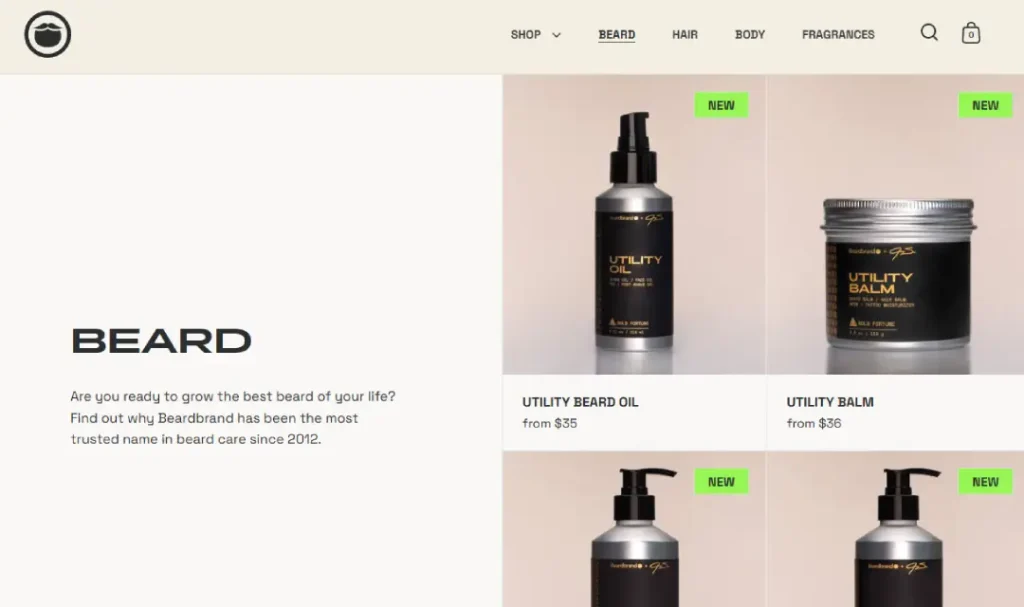
You've checked all the prerequisite boxes – strategy is locked, audiences are understood, designs are stunning, technical implementations are rock-solid, and processes are documented. Your massive website redesign is finally ready for launch!
Not so fast, though! Even with every “t” crossed and “i” dotted upfront, redesign launches can still be chaotic and rife with potential snags if not carefully orchestrated. Let's run through some crucial tips for smoothly navigating that pivotal go-live period before riding off into the sunset.
Have a Rollout Plan (And Backup Plan)
Hopefully, this goes without saying, but you can't just flip a switch and unveil your redesigned website without meticulous planning around the launch itself. Too much is at stake – plus, there are all sorts of potential curveballs Murphy's Law loves throwing your way.
At a minimum, construct a highly detailed, phased rollout plan that accounts for aspects like:
- Dynamic content/data migrations from legacy environments
- Load testing and staging environment validations
- Monitoring implementations to measure every metric
- Contingency communication plans for any issues
- DNS propagation considerations for new hostnames
- Redirects mapping for preserved link equity
- Staggered releases for load balancing if needed
- Clear before/after task milestones and owner assignments
- Established on-call SWAT teams and stakeholder approvals
And don't just identify Plan A! Have backup contingencies thoroughly mapped for handling worst-case failure scenarios, too. You could revert to the old site temporarily. You can also use advanced CDN or hosting features to ramp up traffic gradually.
The bottom line is that we hope for the best, but we must plan for potential disasters and chaos. Don't let a single point of failure derail all your hard work! Comprehensive rollout plans and backup fallbacks are essential insurance policies.
Overly Communicate (Over and Over Again)
Have you gone above and beyond with your internal and external communications about the upcoming site overhaul? Think again – and then double down on those efforts!
The reality is that only a tiny amount of messaging can be considered too much when it comes to significant website relaunches with vast cross-functional impacts and risks. You need to overly communicate every last detail early, proactively, and repeatedly to stakeholders across the entire organisation:
- Marketing, sales, customer service/support teams
- Content owners, subject matter experts, gatekeepers
- IT, developers, engineering, operations, security
- Top leadership, executive spokespeople
- Significant partners, customers, investors, and any web reliant 3rd-parties
Ensure nobody is surprised when things start changing and tracking differently around your digital presence. Socialise key milestones, anticipated stats fluctuations, new governance protocols, and more through multiple channels like:
- Email communication plans dripped over time
- Dedicated Slack channels or chat groups
- Internal knowledge base materials and FAQ repos
- Leadership videoconference sessions and town halls
- External blog, social, and support documentation
And don't just push messaging in one direction, either! Actively solicit buy-in and feedback from all corners at every stage. You may need to rework certain rollout aspects or adjust processes based on stakeholder concerns and input. That's perfectly fine – a smooth launch requires maintaining cross-functional alignment.
The last thing you need is a disgruntled department feeling blindsided, causing preventable chaos and firefighting amid an already high-stress situation. Overcommunicate the living daylights out of your plans to prevent any surprises and knee-jerk reactions when the big moment strikes.
Start Gathering Insights Immediately
Your website may have just relaunched with fireworks and fanfare today, but tomorrow, you need to kick into analytics hyperdrive immediately! Save time sitting back and basking in today's successful go-live.
From the second fresh experience, pushed live, you need comprehensive, accurate user monitoring, behaviour tracking, and performance telemetry running at full tilt. This is your opportunity to gather invaluable insight from the honeymoon period while everything is new and novel to site visitors.
Start instrumenting and closely watching metrics across the entire analytics stack:
- User-centric: Funnels, scroll-maps, heatmaps, session recordings, survey feedback, user testing, A/B experiment data
- Technical: RUM, Synthetic, Core Web Vitals, CDN/Hosting stats, uptime monitoring, error reporting
- SEO & Acquisition: Impressions, rankings, traffic sources, crawl behaviours, flow metrics
- Conversion & Revenue: Ecommerce stats, lead gen metrics, goal completions, attribution
- Content & Engagement: Video/media consumption, page views, time on page, bounce rates
Don't just sit back and passively collect this data, either! Have cross-functional strike teams actively sifting through incoming insights, identifying trouble spots and UX friction points that require immediate triage.
You may notice abnormal bounces at a particular conversion stage, indicating a blocker. A new content or landing page needs to perform better and deserves a second look. You may even pick up on load-bearing pages regressing in Core Web Vitals.
The sooner you can dissect those initial pain points through fresh data, the quicker you can take decisive action in optimisations, refinements, and iterations before escape velocities kick in. Getting that continuous improvement cycle humming ensures maximum ROI from your relaunch's opening moments.
Keep Up That Post-Launch Momentum
Speaking of continuous improvement – your brilliant redesign initiative can't just stop cold after a successful launch day or week. That's simply the beginning of an ongoing commitment to enhancing and future-proofing your digital experience!
Far too many brands make the mistake of cutting website teams down to skeleton crews after going live. They take an ill-advised “set it and forget it” mindset, only to see fresh experiences stagnate and degrade in quality over time.
Don't you dare fall into that trap! Instead, make sure you have full-steam resourcing and staffing in place to not only analyse the flood of new user data but quickly act on those insights through frequent release cadences:
- Rapid A/B test spins for incrementally enhancing UX
- Bi-weekly or monthly content publishing schedules
- Routine front-end engineering sprints (design system, code enhancements/optimisations, etc.)
- Back-end DevOps automation, like hosting and security upkeep
- Ongoing performance audits and grievance procedures
- New feature roadmap execution to delight customers
The post-launch period is prime time to rack up “quick wins” that reinforce the value of your massive overhaul while momentum is hottest. Keep updating and upgrading that digital presence at a blistering pace until you've achieved steady optimisation.
Plus, market and customer demands will evolve rapidly alongside new technology capabilities. Staying agile and elastic with your now-modern web foundation allows you to nimbly adapt rather than growing obsolete or falling behind once more.
So don't take your foot off the pedal after that victorious relaunch! Simply change gears into sustained long-haul cruising to capitalise on every last ounce of investment and hard work that got you to this point. The end of one project is the beginning of another!
FAQs About Killer Website Design
To sum up our comprehensive guide to cool enterprise website design, here are some flash answers to often-asked questions on this vitally important aspect:
What is the most crucial part of web designing?
There is no single “most important” aspect – effective site design involves balancing elements like branding, visuals, UX, content, SEO, speed and others into a unified whole. But if you had to choose one priority task, it would probably be optimising for core user experience and conversions above all else.
How much should I spend on a new company website design?
Correct budgets can wildly vary depending on scope – from twenty to fifty thousand dollars for fundamental informational sites to one hundred thousand to five hundred thousand dollars for enterprise-grade ecommerce redesigns or more than a million dollar digital experiences that are highly complex. However, there is an unspoken golden rule of budgeting at least 20% more than you initially estimated to cater for inevitable scope creep and overages.
What skills does company website design require?
Modern web design calls for a diverse team with expertise in various creative fields such as UX (User Experience) Design, Visual Art Direction, Content Strategy and also technical areas, including UI Engineering, Front-End/Back-End coding or programming languages such as Java or Python/Django/Node.js/Rails/.NET etc., DevOps (Development Operations), SEO (Search Engine Optimisation), Analytics & Reporting Tools used by Web Analysts Project Managers who work alongside Developers when building or maintaining websites projects.
How often must I change my corporate /business website?
Most experts suggest completely redesigning/rebuilding corporate sites every 3-5 years to stay current and optimised. Nonetheless, established brands still need significant updates along the lines of continuous iteration through A/B testing and other optimisations like content refreshes within 12–24 months cycles.
What is a website design process?
While methodologies differ, a sound process generally incorporates strategic planning, user research, content strategy, information architecture, wireframing/prototyping and visual design & UI, as well as further stages such as front-end engineering, back-end integrations, QA testing, analytics, and modelling post-launch optimisation.
How do you make website design look modern?
Current site aesthetics favour clean and minimalist layouts that employ whitespace intelligently. Other indicators include strong typography, background videos, immersive imagery/animations, micro-interactions, flat colours/edges, material/neumorphic UI stylings, and seamless device responsiveness.
How can I make website conversions better through web designing?
Have a mercilessly customer-first UX that facilitates intuitive navigation without friction in scanning your content, establishing clear calls to action, and implementing simplified conversion flows based on robust A/B tests. At the same time, focusing on technical performance optimisation, which may come from fast load speeds, is crucial.
What are the elements of web design that enhance SEO?
When properly implemented, contemporary SEO practices like mobile-friendly responsive layouts, semantic HTML5 markup multimedia integration, descriptive alt-text fast page-load speeds, crawlable link structures, and HTTPS/SSL enablement, among others, may strengthen organic visibility in search engines.
What are some examples of bad website design mistakes?
Some typical mistakes include disorganised navigation structures, aggressive popups/interstitials, poor mobile optimisation, frustrating user workflows, slow page speeds, dated or stale brand aesthetics, lack of accessibility for disabled users like poorly handled error messages (not validating forms) or not supporting screen readers whatsoever +301 redirects instead being misused then this or even having an outdated copyright year displayed at the footer section). This way, such adverse effects could impact rankings negatively, making it impossible for those individuals without disabilities to navigate quickly, while someone using assistive technology may not be aware if they have made any errors until after trying other ways around, such as refreshing a page which will then show them what went wrong making them think otherwise.
Where do you find ideas for outstanding website designs?
Look at award-winning web design galleries or examples from various sources such as Awwwards, CSS Design Awards, The FWA, Behance, Dribbble, etc. But always consider your brand’s specific lens for copying rather than copying directly.
Where is the future of web design going?
Some emerging trends are more immersive 3D / Augmented Reality mergers, fancy micro-animations, more advanced personalisation, ambient/voice UIs, adaptive progressive experiences, sustainable design principles and further steps in performance optimisation along with much broader adoption of modern front-end frameworks and architectures.
The FAQs just presented for company website designing are a very fast snapshot. The final primary keys here are user experience first, technical performance, tailor-made branding, and constant iterative improvement through a purposeful design process built for the long term. Put together all those elements ideally, and you will be well on your way to a great digital experience!
